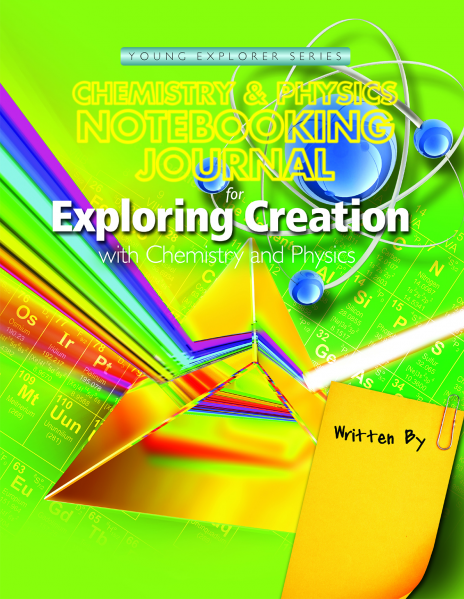Exploring Creation with Chemistry and Physics
The Essentials - What you need to know
- Apologia
- Exploring Creation with Chemistry and Physics and Exploring Creation with Chemistry and Physics Notebooking Journal
- Grade K - 6
- A hardbound textbook and a spiral bound journal.
- Textbook: $39, Journal: $24
The Review
 Apologia does a fantastic job with their young explorer series of homeschool science curriculum. Exploring Creation with Chemistry and Physics is no exception. Written by Jeannie Fulbright, the textbook is comprehensive, yet easy to understand. Written for elementary students, grades K - 6, I wanted Zippy to use this book because I believe that it will help her achieve a solid introduction to the subjects, before moving on to "real" chemistry and physics in high school in just a few short years.
Apologia does a fantastic job with their young explorer series of homeschool science curriculum. Exploring Creation with Chemistry and Physics is no exception. Written by Jeannie Fulbright, the textbook is comprehensive, yet easy to understand. Written for elementary students, grades K - 6, I wanted Zippy to use this book because I believe that it will help her achieve a solid introduction to the subjects, before moving on to "real" chemistry and physics in high school in just a few short years.The books are of the highest quality both in physical appearance and content. The textbook is a hardbound textbook sized book. It is well organized with a table of contents, index, answer key and extensive supply list. As with other Apologia books in the young explorer series there is a through introduction on how to use the book along with the journaling notebook. With these sound instructions, I believe that anyone would feel comfortable teaching science. The text has fourteen lessons including topics of matter, atoms, compounds, mixtures, simple mechanics, motion, kinetic energy, sound, light, thermal energy, electricity, and magnets.

The methodology of this series is based heavily on the Charlotte Mason approach. The notebooking journal adds another layer to the learning. As it says in the Note from the Author at the beginning of the journal, "It provides a place for students to complete the assignments in the test as well as many optional activities, and will serve as their individual notebook." Extra extensions to the text include crosswords, copywork, mini books, additional hands on activities, project pages and field trip sheets.
In addition to all the wonderful resources to be found in the text and notebooking journal, Apologia provides a course website with online resources. One of my personal favorite links is the video showing how to blow a bubble with bubble gum, which is part of an activity in chapter 2.
 Zippy is still having a blast working her way through this book. There is a lot of really information rich text, but there is just as great an amount of trying it out. More than I
Zippy is still having a blast working her way through this book. There is a lot of really information rich text, but there is just as great an amount of trying it out. More than Ihave seen in any of the other young explorer series. So much, in fact, I felt a little overwhelmed. It makes sense that a book about chemistry and physics would have so many actives as these concepts are so well suited to them. Just think, when we cook we are using chemistry, and that is an activity many do every single day. Many of the "try this" activities throughout each chapter are simple activities requiring things that are really found around the house and take just a few minutes to complete. At the end of the chapter, and additionally in the notebooking journal, there are more complex projects. Zippy's favorite project so far involved playing with density.
Thinking back on my own public school science education, I know that I learned all the concepts in this book, but I learned most of it in high school and college. This book does not shy away from big information like atoms, the periodic table, even Newton's Laws of Motion. It shares this big information in such an understandable way, with the help of lots of activities, without sounding patronizing that even a young child would be able to comprehend. The other aspect of this book that I absolutely love, love, love is the Christian worldview. Science is a beautiful lens that can help us see the hand of the Creator. There is scripture in the copywork, sprinkled throughout the text, and the author is always careful to give glory to God in her writing.
For the duration of the review period we used. Exploring Creation with Chemistry and Physics as our sole science text. We tried a couple of different approaches to the activities. Zippy read through the whole chapter, completing the notebooking activities and end of chapter questions then did the activities. For a difference chapter she did the activities as she came to them in the chapter. The second approach probably worked the best, pedagogically speaking. I would suggest, as a parent, to look ahead, review all the activities, and collect in one spot all the materials necessary for that chapter. We got hung up a couple of times because of my lack of foresight.
All in all, I love this book. It is proving to be the perfect introduction to some complex topics. By learning these concepts now, I believe it is setting Zippy up to be more successful in science in her higher education.




ReplyDelete主播免費祼聊聊天室
午夜視頻聊天室真人秀場
免費裸體美女聊天室
免費夫妻視頻真人秀
美女主播免費祼聊聊天室
夫妻真人秀聊天室
夫妻真人秀視頻聊天室
同城美女視頻聊天室
台灣真愛旅舍聊天室
啪啪免費視頻在線觀看